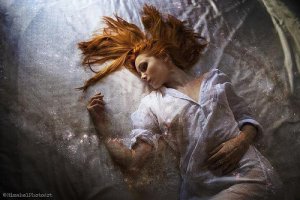Sleep Paralysis: When Nightmares Are Alive

Do you ever imagine waking up in the middle of the night and feel like you are paralyzed? Your body finds itself completely immobile, you feel pressure on your chest, and, worst of all, you could have sworn that someone or something wicked and perverse was present with you. It seems like a horror movie. But the truth is that this happens to those who suffer from sleep paralysis.
What is sleep paralysis?
It is a disorder that makes you experience the normal stages of sleep outside the natural order. Basically and in simple terms, your mind wakes up before your body does.
Generally when you go to bed, first you fall asleep or you lose consciousness, to say it another way. Then, chemicals in your brain cause your body to be “paralyzed.” You start dreaming and even if you are running, jumping, or dancing in your dreams, these chemicals make you stay quietly in your bed. When day starts to break, you stop dreaming and start recovering mobility in your body. Finally, you wake up.
Now, imagine that this process were to happen out of order. What happens if your body continues producing glycine and GABA (the two chemicals that paralyze your body), even after it has woken up? Well, you would wake up before you recovered mobility in your body. What if some features of your dreams were to mix with your conscious state of mind? This combination is capable of producing a truly frightening experience.
Beliefs and symptoms
Being paralyzed makes a person feel defenseless. They cannot cry for help or satisfy their normal instinct to protect themselves. When someone finds themselves in such a vulnerable state, it is possible for their deepest fears to take control of them.
So it is reasonable for the person to think, “If I am not in control of my body, who is controlling it?” Many people who have suffered episodes of sleep paralysis come to the conclusion that a malicious force is attacking them. These ideas are influenced by religious and cultural beliefs. Depending on the events that take place, the person may end up thinking that he has been possessed by spirits, aliens, demons, or other mystical creatures.
But regardless of how each of us explains the experience, the truth is that some symptoms that are common to all people are a lack of air, pressure on their chest, a lack of bodily motion, and the ability to perceive details in their surroundings clearly, for example, the bed, the nightstand, the clock, etc. In almost all cases, the episodes occur when the person is sleeping on their back.
Before going to bed
The regular practice of exercising each and every day will contribute to more peaceful sleep at night. It will also help if, at least once or twice a day, you take a break from your work, closing your eyes, relaxing, and breathing deeply.
Another piece of advice is to avoid excessive caffeine and to try to go outside and get some fresh air for at least 30 minutes every evening. And make an effort to keep a regular schedule so that you sleep enough each night.
What to do during an episode
Some people have had good results by concentrating on moving one small muscle, for example, their finger or their neck and so in essence they manage to “wake up” their body. Others focus on breathing calmly until their body starts recovering its activity. In any case, try to stay calm and see what is happening to you through the eyes of logic.
Carla MacKinnon*, who has suffered from this disorder since childhood and has done extensive research on the topic, says, “I have found that thanks to focusing on the details of the experience and comparing them to my studies, I can distract my mind from the sensation of fear and danger. In this way, I eliminate the dark, overwhelming power that used to reign in such experience.”
Has something similar happened to you before? Take heart, you are not alone and you can even fight this terrifying disorder.
Image courtesy of Gabriele Negri
* Carla MacKinnon coordinates The Sleep Paralysis Project and he has developed a short film called “Devil In The Room,” which was completed in May of 2013. This movie combines techniques like stop motion animation, live action film, and project mapping to evoke and explore the words experienced between consciousness and sleep. The movie is a graduation thesis by Carla MacKinnon for the Royal College of Art’s Animation Masters course, created in collaboration with the art and technological resources of Seeper studies.
This text is provided for informational purposes only and does not replace consultation with a professional. If in doubt, consult your specialist.








